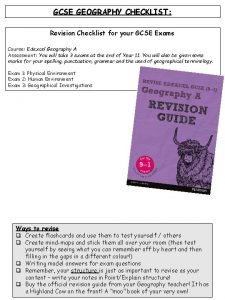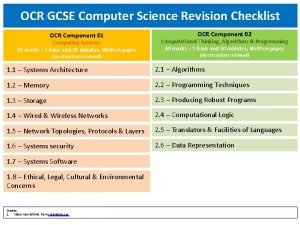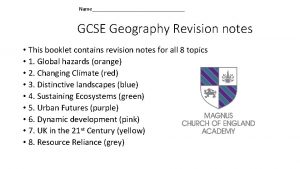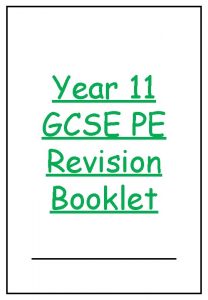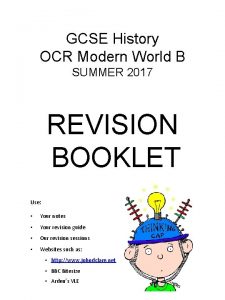GCSE GEOGRAPHY CHECKLIST Revision Checklist for your GCSE







- Slides: 7

GCSE GEOGRAPHY CHECKLIST: Revision Checklist for your GCSE Exams Course: Edexcel Geography A Assessment: You will take 3 exams at the end of Year 11. You will also be given some marks for your spelling, punctuation, grammar and the used of geographical terminology. Exam 1: Physical Environment Exam 2: Human Environment Exam 3: Geographical Investigations Ways to revise q Create flashcards and use them to test yourself / others q Create mind-maps and stick them all over your room (then test yourself by seeing what you can remember off by heart and then filling in the gaps in a different colour!) q Writing model answers for exam questions q Remember, your structure is just as important to revise as your content – write your notes in Point/Explain structure! q Buy the official revision guide from your Geography teacher! It has a Highland Cow on the front! A “moo” book of your very own!

GCSE Geography – What I need to know! Revision Checklist: Exam 1 The Physical Environment Check-list Changing UK Landscapes Main UK rock groups (sedimentary, igneous and metamorphic) and know examples of them Distribution of rocks in the UK Explain rock formations e. g. Batholiths Know different land-uses in the UK (e. g. agriculture, forestry, tourism) and the problems/benefits they bring Coasts Explain what Erosion, Weathering and Slumping is Explain the following processes of erosion: • Hydraulic action • Abrasion • Attrition • Solution Explain the features and types of waves: • Fetch • Swash • Backwash • Construction • Destructive Explain the following processes of. Transportation: • Traction • Saltation • Suspension • Solution Explain Longshore Drift (using the key word TRANSPORTATION and a labelled diagram) Depositional Landforms Explain how the following are formed using the key word DEPOSITION, examples of processes of erosion and a labelled diagram: • Spit • Bar • Tombolo Can do! Revise me!

Revision Checklist: Exam 1 The Physical Environment – continued… Check-list Coasts continued… Explain the influence of geology (hard/soft rocks): • concordant (same rock) • discordant coasts (different rocks that form headlands and bays) Coastal management: • Explain and give examples of hard and soft engineering • Explain how a coastal management scheme can cause conflicts (Holderness Coast – Mappleton). Rivers The key words and definitions about rivers (watershed, tributary, confluence, source, mouth, drainage basin) Explain the main physical process: Erosion • Hydraulic action • Abrasion • Attrition • Solution Weathering • Chemical • Biological • Mechanical Transportation • Traction • Saltation • Suspension • Solution Explain the formation of river characteristics/features in different courses: • Upper: V-shaped valley and waterfall • Middle: Meander and ox-bow lake • Lower: Levee Causes and effects of flooding: • Physical (rainfall intensity, geology, snowmelt) • Human (urbanisation, agriculture, industry) Can do! Revise me!

Revision Checklist: Exam 1 The Physical Environment – continued… Check-list River continued… Be able to interpret hydrographs River management: • Explain and give examples of hard and soft engineering • River Dee case study Climate Understand: • Global atmospheric circulation cells (Hadley, Ferrel and Polar) • Oceanic circulation (e. g. Gulf Stream and North Atlantic Drift) Explain the causes of climate change: • Natural - Malankovitch cycles (Eccentricity cycle, axial tilt, precession cycle) • Human - industry, energy, farming Know what factors influence the UK’s climate (maritime air mass, continental air mass, prevailing winds, North Atlantic Drift) Explain how tropical storms form Identify the main hazards of tropical storms (e. g. winds, rainfall, storm surges, flooding and landslides) Hurricane Sandy and Typhoon Haiyan case studies: • Location • Social, economic and environmental impacts • Response of individuals, organisations and the government Identify Arid locations (deserts) and explain their formation Explain the causes of drought: • Meteorological • Hydrological California and Ethiopia drought cases studies: • Location • Social, economic and environmental impacts • Response of individuals, organisations and the government Can do! Revise me!

Revision Checklist: Exam 1 The Physical Environment – continued… Check-list Ecosystems Understand the terms ecosystem and biome Give examples of biomes and their locations (tropical, boreal, temperate, tundra, deserts) Tropical rainforest case study: • Biotic and abiotic features • Adaptions of plants and animals • Goods and services it provides (eg. Fruits, ingredients for drugs, timber, it stores carbon, tourism and home to indigenous tribes) • Causes and effects of deforestation (roads, logging, population growth, ranching, agriculture • Sustainable management strategies Deciduous woodlands case study: • Biotic and abiotic features • Adaptions of plants and animals • Goods and services it provides (eg. Wood for construction, tourism) • Causes and effects of deforestation (replanting with conifers, need for farmland, demand for roads/new homes) • Sustainable management (e. g. The New Forest National Park) Be able to interpret the Gersmehl model for different biomes (e. g. tropical rainforests and deciduous woodlands) Can do! Revise me!

Changing UK Landscapes Main UK rock types Distribution of rocks in the uk Batholiths Land-use in the uk (agriculture, forestry, tourism) Coasts Explain what Erosion, Weathering and Slumping is Explain the following processes of erosion: • Hydraulic action • Abrasion • Attrition • Solution Explain the features and types of waves: • Fetch • Swash • Backwash • Construction • Destructive Erosional Landforms Explain how the following are formed using the key word EROSION, examples of processes of erosion and a labelled diagram: • Headlands and bays • Caves, arches, stacks and stumps, • Wave-cut platform (and wave-cut notch) Explain Longshore Drift (using the key word TRANSPORTATION and a labelled diagram) Transportation: Traction/saltation/suspension/solution Depositional Landforms Explain how the following are formed using the key word DEPOSITION, examples of processes of erosion and a labelled diagram: • Spit • Bar • Tombolo Influence of geology (hard/soft rocks) Concordant (same rock) and discordant coasts (different rocks that form headlands and bays) Coastal management Hard/soft engineering Holderness coast case study

Rivers The key words around rivers (watershed, tributary, confluence, source, mouth, drainage basin) What are the main physical process (erosion, weathering, mass movement) River characteristics/features in different courses (upper, middle and lower) and their formation Causes and effects of flooding – physical (rainfall intensity, geology, snowmelt) and human (urbanisation, agriculture, industry) Be able to interpret hydrographs River management – hard and soft engineering River Dee case study Climate Global atmospheric circulation – circulation cells and oceanic circulation Natural causes of climate change - Malankovitch cycles (Eccentricity cycle, axial tilt, precession cycle) Human causes of climate change – industry, energy, farming UK’s climate (maritime air mass, continental air mass, prevailing winds, North Atlantic Drift) How tropical storms form Hazards of tropical storms (winds, rainfall, storm surges, flooding and landslides) Hurricane Sandy and Typhoon Haiyan case study (location, social, economic and environmental impacts, response of individuals, organisations and the government) Arid locations (deserts and their formation) Causes of drought (meteorological/hydrological) California and Ethiopia cases study (location, hazards, impacts on people and ecosystems, responses from individuals, organisations and the government) Ecosystems What is a biome Examples of biomes (tropical, boreal, temperate, tundra, deserts) Tropical rainforests – biotic and abiotic features, adaptions of plants and animals, goods and services eg. Fruits, ingredients for drugs, timber, it stores carbon, tourism and home to indigious tribes), deforestation (roads, logging, population growth, ranching, agriculture) and sustainable management. Deciduous woodlands – abiotic and biotic features, adaptions of plants and animals, good and services eg. Wood for construction, tourism), deforestation (replanting with conifers, need for farmland, demand for roads/new homes), sustainable management (e. g. The New Forest National Park) Gersmehl model
